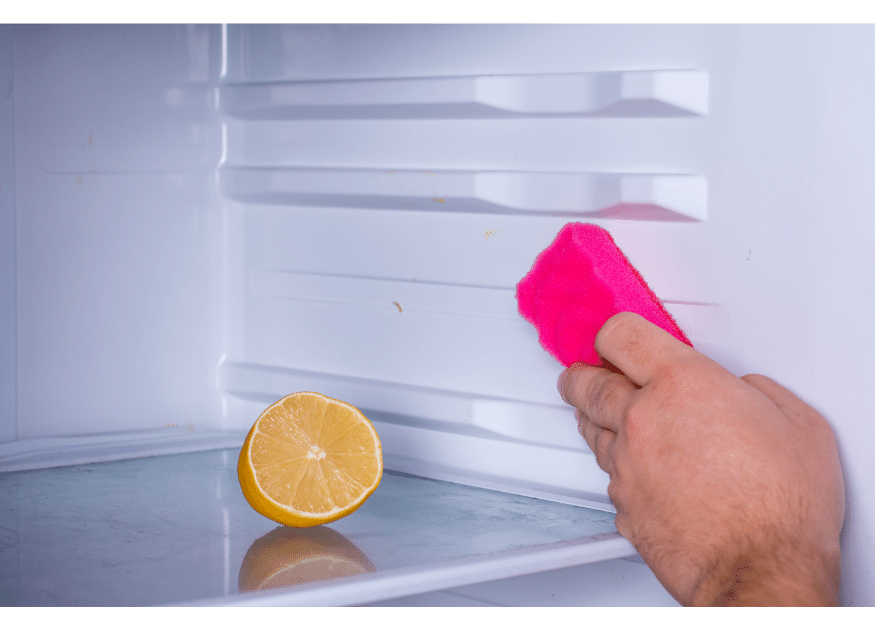The ordinary family fridge may become home to all or any of the above, not to mention a weird odor that assaults your nose every time you open the fridge door. Yes, the welcoming light and cold greeting might give you a false sense of security. Unfortunately, your refrigerator is a Trojan Horse when it comes to storing substances that might cause harm.
We all understand how vital it is to clean the inside of our refrigerators, but did you know there are additional advantages to cleaning the outside? The outside of your refrigerator, particularly the space beneath, can collect a lot of dirt, dust, and food residue, producing a breeding ground for viruses and mold. One of the most commonly used appliances in your home, allowing important outside components of your refrigerator, such as condenser coils, to become clogged with dust can significantly reduce its performance. Regular cleaning and maintenance will extend your life and improve the appearance of your refrigerator. Here’s how to clean the outside of your fridge in a few simple steps.
How dirty is your refrigerator?
A study in a poorly kept home fridge discovered that salad drawers alone contained an average of 7,850 bacterium units per square centimeter, or over 800 times the quantity of bacterial units considered acceptable for food preparation.
How frequently should you clean your refrigerator?
Cleaning your refrigerator once a week is advised by experts; pay special attention to the crispers and meat storage sections. Every three to four months, a thorough cleaning should be performed, which includes taking everything out to clean. Every two to three months, freezers need to be cleaned.

How to Eliminate Fridge Odors
Unless you take preventative measures, your refrigerator can provide a perfect setting for bad odors. Fortunately, you can eliminate bad refrigerator odors without using harsh chemical treatments. After you’ve cleaned and dried all surfaces, deodorize your refrigerator by filling an open container with dry baking soda and placing it on the lowest shelf. This will prevent future odors from remaining near your food, so keep it there as you refill your fridge.
After cleaning and deodorizing your refrigerator, return everything to its original state. Now is also an excellent time to clean out and organize your refrigerator. Toss any outdated or damaged food, arrange like goods together, and consider utilizing bins and containers to organize items.
Cleaning the Refrigerator’s Gasket
Pay close attention to the rubber gasket surrounding the fridge door. To ensure a tight seal, it must be cleaned on a regular basis. For ordinary filth, use warm water and liquid dish soap; if mold is found, use bleach-based cleaning. Rinse well and dry. To prevent the seal from drying, apply a thin layer of petroleum jelly ($2, Target).
Cleaning the refrigerator’s water dispenser
To keep enjoying fresh, filtered water from your refrigerator, give the water dispenser a good cleaning every now and then. Before cleaning, read the owner’s manual, just like you would with refrigerator coils. Systems differ, and a handbook can provide detailed instructions and information for troubleshooting serious water dispenser issues. Check the handbook for water dispensers and ice machine filter replacement schedules. Replacing the filter as instructed will keep the dispenser and ice machine in operating order.
The water dispenser tray is prone to stains and wet marks. To clean it, apply a vinegar-based cleanser ($5, Home Depot) and let it dry. If the tray is removable, remove it and clean it in your sink. Also, clean underneath the tray. A soft toothbrush may penetrate into any corners, crannies, or vents.
Preventive Measures for Keeping Your Refrigerator Clean
A few simple techniques will help your refrigerator appear (and smell) fresher for longer. To avoid sticky spills, do not reload the fridge with sloppy food containers or damaged fruits and vegetables. Immediately discard anything that has expired or is of questionable freshness. To remove drips or crusty lids from jars, bottles, or cans, use baking soda and water. Make sure to use clean towels and completely dry everything before putting it back. To make things easier, clean refrigerator items as you use them for cooking and meal preparation.
Take time once a week to discard any rotting vegetables or leftovers that have accumulated in the back of the refrigerator. Check the expiration dates on dairy and condiments, and discard anything that is past its prime. Removing these items keeps odors and sticky spills out of your freshly cleaned refrigerator.

Guidelines for Keeping Your Fridge Clean include:
- Spills should be wiped up quickly with hot, soapy water.
- Rinsing jars, containers, and bottles that may become coated with food from the outside.
- Dispose of expired items regularly and leftovers more often.
- Avoid using solvent cleaning chemicals and abrasives since they can harm your fridge and disrupt temperature regulation.
- Clean the internal shelves and drawers with warm, soapy water.
- Wiping the fridge door handle, the most often handled portion of the refrigerator,.
- Dusting the front grill of your refrigerator helps to preserve airflow and cooling efficiency.
Refrigerators are central to your kitchen, and hence your entire home. Make the heart of your house a refuge by keeping your fridge clean!
Unless you take preventative measures, your refrigerator may provide a perfect setting for bad odors. Fortunately, you can eliminate bad refrigerator odors without using harsh chemical treatments. After you’ve cleaned and dried all surfaces, deodorize your refrigerator by filling an open container with dry baking soda and placing it on the lowest shelf. This will prevent subsequent smells from remaining near your food, so keep it there as you refill your fridge.
After cleaning and deodorizing your refrigerator, restore everything to its original state. Now is also an excellent time to clean out and organize your refrigerator. Toss any outdated or damaged food, arrange like goods together, and consider utilizing bins and containers to organize stuff.
